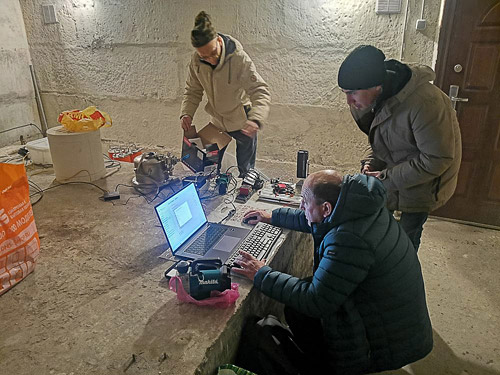
Electronic english version since 2022 |
The newspaper was founded in November 1957
| |
In the Laboratory of Nuclear Problems
A year of laser inclinometers in Kamchatka:
a step closer to predicting earthquakes
In December 2024, the employees of the Department of Research and Innovation of the Laboratory of Nuclear Problems Alexey Krasnoperov, Alexey Kuzkin, Roman Ni and Mikhail Lyablin visited the Kamchatka Branch of the Federal Research Centre "Unified Geophysical Service of the Russian Academy of Sciences" and the Vitus Bering Kamchatka State University.
 |
| Alexey Kuzkin, Alexey Krasnoperov and Roman Ni |
They serviced two small-sized precision laser inclinometers (PLI) installed in Petropavlovsk-Kamchatsky. M.V.Lyablin made reports on a new type of angular interferometer and on the construction of a small-sized inclinometer based on it.
The annual stage of operation of two inclinometers installed in different parts of the city of Petropavlovsk-Kamchatsky at a distance of 5.6 km from each other was completed. The inclinometers synchronously registered microseismic events. These devices are unique in that they allow registering angular changes in the earth's surface with an unprecedented accuracy of ten nanoradians that is 100 times greater than the capabilities of traditional devices.
Servicing the inclinometers included replacing the oil in its cuvette with subsequent adjustment and calibration, as well as testing the remote data transmission.
The first results were obtained as a result of annual measurements.
- The effect of an irreversible change in the angular position of the earth's surface after large earthquakes was registered. For example, an earthquake with a magnitude of seven on the Richter scale caused a change in the surface tilt of about three microradians that was clearly registered by the inclinometer.
- The first data on the natural oscillations of the Earth with a characteristic amplitude of only ten nanoradians were obtained.
- Time synchronization of inclinometers allows producing "videos" of landscape changes. It can help to identify areas of seismic energy accumulation, as well as to register earthquake precursors, such as the absorption of the Earth's natural oscillations at the sites of crustal fault production.
These results are currently in the publication stage.
Mikhail Lyablin held two seminars at the Institute of Cosmophysical Research and Radio Wave Propagation of the Far Eastern Branch of the Russian Academy of Sciences (IKIR) and the Kamchatka Branch of the Federal Research Centre "Unified Geophysical Service of the Russian Academy of Sciences" to present a new type of angular interferometer and its application in the next generation of inclinometers.
The use of a new type of angular interferometer will significantly reduce the overall dimensions of inclinometers and take a step towards implementing a project for a submersible inclinometer with external dimensions less than 9 cm in diameter. It will allow installing such inclinometers in a pit and measuring the physical slopes of the earth's surface in rocky soil.
Both reports aroused great interest from the point of view of the possibility of registering low-frequency angular movements of the Earth's surface by a network of inclinometers. Such a network will allow identifying seismic energy accumulation zones.
Article prepared as reported by the Scientific Communications Group of the Laboratory of Nuclear Problems